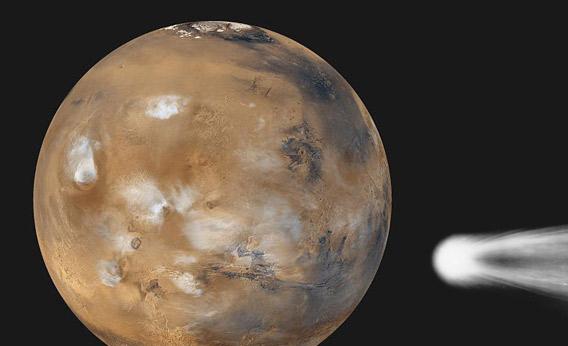Create a free profile to get unlimited access to exclusive videos, sweepstakes, and more!
TWIST Episode 4: Will Mars Get Whacked by a Comet in 2014?

On the current episode of my weekly science news wrap-up web series This Week in Science and Technology, my co-host Carin Bondar and I talk about the link between breastfeeding and ovarian cancer; a comet that has a chance of hitting Mars in 2014; and that maybe, just maybe, that scene where Spiderman stops a commuter train with his web-slinging isnât so implausible after all.
I filmed my bit about the comet and Mars last week, and since then there have been some updates. I wrote an overview of the situation as it stood a few days ago, so read that first.
At that time, the nominal miss distance of the comet was about 100,000 kilometers, or 60,000 miles. That was based on observation spanning about 70 days, and when it comes to predicting asteroids and comets, the longer the time baseline of observations you have, the better. Knowing the position of the comet now, its orbit was backtracked to see if any earlier observations were made of the sky that had the comet in them, and some were found from the Pan-STARRS observatory from October 2012. This extended the observational baseline to 148 days, giving astronomers more accuracy in the prediction for this close encounter with Mars.
The result? Now it looks like the comet will skim the surface of Mars at a distance of a mere 50,000 km (30,000 miles)! Thatâs very close. According to comet hunter Leonid Elenin, the probability of a direct impact by the comet nucleusâthe solid chunk of rock and ice measuring 15-50 km acrossâis less than 0.1%. However, as I wrote before, itâs expected that the nucleus will be surrounded by a cloud of ice and rubble called a coma. This cloud could be quite large, easily wide enough to have some of that debris hit the planet.
This could be dangerous for the rovers and landers we have on the surface, though itâs unclear just how bad that will be. Even a direct impact by the nucleus wonât necessarily damage the landers. Far more concerning to me are the probes in orbit. There are several working orbiters around Mars right now, including the Mars Reconnaissance Orbiter, Mars Odyssey, and Mars Express (and the Mars MAVEN probe is due to launch this year, and will be in orbit by the time the comet arrives). If the comet passes as close as predicted to Mars, and it has an extended coma, then the danger to those spacecraft is real. Getting hit even by something as small as a snowflake can damage a space probe when that snowflake is moving at 56 kilometers per second (125,000 mph)!Â
Comets, though, are notoriously unpredictable. As we get more observations, and the comet itself vents gas and changes its orbit over time, that near miss may turn into a very wide one, and everything will be OK. It is simply too early to tell. Weâll know better in the coming months as orbital mechanics works its science over this Martian close encounter.
P.S. Due to extensive travel coming up for both Carin and me, TWIST will be on hiatus for a little while. We'll have more news about that soon.


























